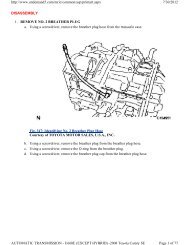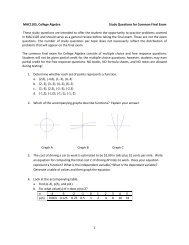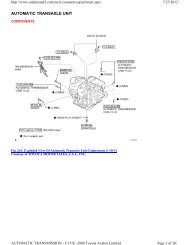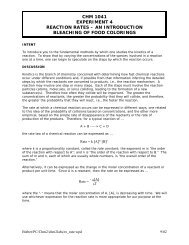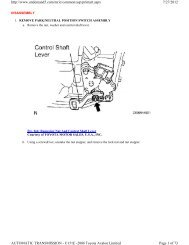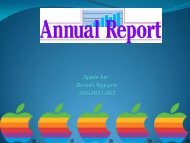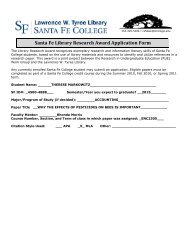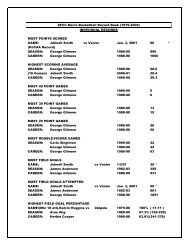Nikon
Nikon
Nikon
Create successful ePaper yourself
Turn your PDF publications into a flip-book with our unique Google optimized e-Paper software.
NIKON<br />
TOM DAVIS<br />
SECTION 001
EXECUTIVE SUMMARY<br />
<strong>Nikon</strong> took heavy losses for 2010 and are at a break<br />
point. Luckily they have the D3 line producing steady<br />
sales for the professional market but if they do not<br />
follow their projected plans to come up with new<br />
products and streamline production, the company will<br />
loose their place as a leader in the imaging market.<br />
http://www.nikon.com/about/ir/ir_library/ar/pdf/ar2010/1<br />
0annual_e.pdf
Corporate Info<br />
Nobuyoshi Gokyu - President & CEO,<br />
<strong>Nikon</strong> Inc.<br />
Head Office – Tokyo, Japan<br />
End of fiscal year- March 2010<br />
Specializes in optical technology –<br />
Digital Cameras yielding 72.5% of sales<br />
Main markets- USA, Europe<br />
Overseas market provide 82.3% of net<br />
sales
Audit Report<br />
Outside Corporate Auditors – Toyoshi<br />
Nakano, Susumu Kani, Masatoshi<br />
Kamijo<br />
The independent auditors concluded<br />
that all figures and representations in<br />
the annual report for <strong>Nikon</strong> for the 2010<br />
fiscal year were completely accurate.
2010 Stock<br />
Stock Price - 2,041 Yen or $25<br />
High- 2,210 Yen<br />
Low- 1,121 Yen<br />
Dividend per share – 8.00 Yen<br />
As of March 31, 2010<br />
Hold – Exciting new products are expected<br />
from <strong>Nikon</strong>. Projected growth is 30 billion<br />
yen in 2011 and 60 billion yen in 2013. The<br />
D3 flagship line is said to out perform<br />
<strong>Nikon</strong>’s closest competitors in the DSLR<br />
market.
INDUSTRY OUTLOOK AND NIKON<br />
FUTURE CLAIMS<br />
The digital camera industry has seen a steady rise in growth from the bottom up. Low- cost,<br />
lightweight, easy to use cameras are in demand by the average individuals with little to no<br />
photography experience. These features make it easy for anyone to afford and pick up and a<br />
very promising profit for imaging companies. Middle and Professional range camera’s round out<br />
the advanced amateur and true professional market of consumers. The integration of true high<br />
definition video into <strong>Nikon</strong>’s cameras has stimulated the industry into increased growth and<br />
creativity.<br />
http://blog.chasejarvis.com/blog/2010/12/reason-2525-why-i-love-hdslrs-eriks-guest-post/<br />
<strong>Nikon</strong> has responded to 2011 net loss of $135 million by restructuring their business process<br />
for efficiency and adjusting their finances to minimize the effect of changes in Japanese<br />
economy have on profits. Their D3 flagship series of professional cameras are regarded as<br />
near perfect and should continue to achieve steady sales in the prosumer market. Upgrades to<br />
most cameras are in the works, expected to see increased ease of use in the amateur line and<br />
creative new features on mid range and professional cameras, including an innovative, mirror<br />
less design.<br />
http://www.bythom.com/nikonroadmap.htm<br />
http://www.radiantlite.com/2010/07/nikon-plans-mirrorless-camera-system-2011.html
INCOME STATEMENT<br />
<strong>Nikon</strong> uses a multi step Income Statement.<br />
Page 14<br />
http://www.nikon.com/about/ir/ir_library/result/pdf/2010/10<br />
_f_c_e.pdf<br />
Despite a large increase of gross profit, <strong>Nikon</strong> took a<br />
huge hit from operations income and net income. Seems<br />
that the economy may not have had such a significant<br />
impact on net income. Internal inefficiencies are more<br />
likely to be at fault.
BALANCE SHEET<br />
Current assets account dropped 34,000, while total assets<br />
only dropped just under 9,000 from year to year. Although<br />
there was a net loss for the 2010 fiscal year, at a glance the<br />
balance sheet looks relatively stable. Until you realize the<br />
figures are in millions of Yen… All accounts took a huge hit<br />
other than current assets and intangibles which nearly<br />
doubled in value.
STATEMENT OF CASH FLOWS<br />
Cash flow difference from 2009 and 2010 are substantial. In 2009, net income was<br />
greater than cash flow from operations which was 28,055 and 10,112 respectively<br />
(millions of Yen). In 2010 however, net income was a loss of 12,615 and cash flow from<br />
operations was 103,497 (millions of Yen).<br />
<strong>Nikon</strong> did not grow as far as investments in Property, plant, and equipment. Figures<br />
stayed close to the same from year to year with the exception of the Construction in<br />
progress account which increased by 5 billion Yen for what is most likely renovations.<br />
<strong>Nikon</strong> financing is primarily through stock sales. However, <strong>Nikon</strong> hopes to increase cash<br />
flows for the 2011 fiscal year by streamlining production and reducing inventories (page<br />
4, item 2) http://www.nikon.com/about/ir/ir_library/result/pdf/2010/10_f_c_e.pdf<br />
Cash assets increased over the past 2 years by nearly 27 billion Yen.
ACCOUNTING POLICIES<br />
Property, plant and equipment are stated at cost. Depreciation of property, plant<br />
and equipment of the Company is principally computed by the declining-balance<br />
method, while the straight-line method is applied to buildings.<br />
Speed of operations without sacrificing quality is important to <strong>Nikon</strong>. Not meeting<br />
market demands not only results in loss of sales but also excess inventory.<br />
Topics of the notes to the financial statements<br />
1. Basis of Presenting Consolidated Financial Statements 2. Summary of<br />
Significant Accounting Policies 3. Investment Securities 4. Inventories 5.<br />
Long-lived Assets 6. Short-term Borrowings and Long-term Debt 7.<br />
Retirement and Pension Plans 8. Equity 9. Stock Option 10. Selling, General<br />
and Administrative Expenses 11. Income Taxes 12. Research and<br />
Development Costs 13. Leases 14. Financial Instruments and Related<br />
Disclosures 15. Derivatives 16. Contingent Liabilities 17. Net Income per<br />
Share 18. Business Combinations 19. Segment Information
Financial Analysis Liquidity Ratios<br />
Working capital – Working capital decreased a large amount, which means both<br />
assets and liabilities were decreased between 2009 and 2010<br />
2009: 518,935 – 289,335 = 229,600<br />
2010: 484,624- 299,827 = 184,797<br />
Current Ratio – Dropped by nearly two tenths of a point.<br />
2009: 518,935 / 289,335 = 1.79<br />
2010: 484,624 / 299,827 = 1.62<br />
Receivable turnover – High frequency of A/R collection , more cash on hand.<br />
2009 - 879,719 / 121,155 = 7.26<br />
2010 - 785,499 / 113,773 = 6.90<br />
ALL FIGURES STATED IN MILLIIONS OF YEN
Profitability Ratios<br />
Profit margin – 2010’s net loss sent the profit margin into the negative range.<br />
2009 – (39,180 / 879,719) x 100 = 4%<br />
2010 – ( -17,672 / 785,499) x 100 = -2%<br />
Asset turnover - Lost .11 cents on the dollar between 2009 and 2010, coming much to<br />
only breaking even.<br />
2009 - 879,719 / 749,805 = 1.17<br />
2010- 785,499 / 740,632 = 1.06<br />
Return on assets – <strong>Nikon</strong> did poorly using assets to generate earnings for 2010<br />
2009 - 28,056 / 749,805 = 3.7%<br />
2010 – (-12,615 / 740,632 ) = -1.7%<br />
Return on equity – Profitability was poor for 2010, in the negative values.<br />
2009 – 28,056 / 397,576 = 7.1%<br />
2010 – (-12,615 / 381,202) = -3.3%<br />
ALL FIGURES STATED IN MILLIIONS OF YEN
Financial Analysis<br />
Solvency Ratio<br />
Debt to equity – Debt to equity ratio from 2009 to 2010 came closer to a 1 to 1 ratio. Reflects<br />
<strong>Nikon</strong>’s poor leverage and struggle with losses.<br />
2009 - 370,718 / 397,576 = 0.93<br />
2010 – 368,562 / 381,202 = 0.97<br />
ALL FIGURES STATED IN MILLIIONS OF YEN
Market Strength Ratios<br />
For the past two years, calculate and comment on:<br />
Price/earnings per share - Market price of share took a massive hit in 2010.<br />
2009 – 70.76<br />
2010 – (-31.82)<br />
Dividend yield – Ratio at which <strong>Nikon</strong> paid out dividends relative to share price<br />
decreased by 200%<br />
2009 – 18 / 70.6 = 0.25<br />
2010 – 8 / (-31.82) = -0.25<br />
ALL FIGURES STATED IN JAPANESE YEN







